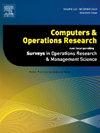Bidding in day-ahead electricity markets: A dynamic programming framework
IF 4.1
2区 工程技术
Q2 COMPUTER SCIENCE, INTERDISCIPLINARY APPLICATIONS
引用次数: 0
Abstract
Strategic bidding problems have gained a lot of attention with the introduction of deregulated electricity markets where producers and retailers trade electricity in a day-ahead market run by a Market Operator (MO). All actors propose bids composed of a unit production price and a quantity of electricity to the MO. Based on these bids, the MO selects the most interesting ones and defines the spot price of electricity at which all actors are paid. As the bids of all actors determine the price of electricity, a bidding Generation Company (GC) faces a high risk regarding its profit when placing bids as the bids of competitors are not known in advance. This paper proposes a novel dynamic programming framework for a GC’s Stochastic Bidding Problem (SBP) in the day-ahead market considering uncertainty over the competitor bids. We prove this problem is NP-hard and study two variants of this problem solved with the dynamic programming framework. Firstly, a relaxation provides an upper bound solved in polynomial time (SBP-R). Secondly, we consider a bidding problem using fixed bidding quantities (SBP-Q) that has previously been solved through heuristic methods. We prove that SBP-Q is NP-hard and solve it to optimality in pseudo-polynomial time. SBP-Q is solved on much larger instances than in previous studies. We show on realistic instances that its optimal value is typically under 1% of the optimal value of SBP by using the upper bound provided by SBP-R.
日前电力市场竞价:动态规划框架
随着放松管制的电力市场的引入,生产商和零售商在由市场运营商(MO)运营的提前一天市场上交易电力,战略投标问题得到了很多关注。所有参与者向MO提出由单位生产价格和电量组成的投标。基于这些投标,MO选择最有趣的投标,并定义所有参与者支付的电力现货价格。由于所有参与者的出价决定了电价,因此由于竞争对手的出价事先不知道,投标发电公司在投标时面临着较高的利润风险。本文提出了考虑竞争对手出价不确定性的日前市场GC随机竞价问题的动态规划框架。我们证明了这个问题是np困难的,并研究了用动态规划框架求解这个问题的两个变体。首先,松弛提供了在多项式时间内求解的上界(SBP-R)。其次,我们考虑了一个使用固定投标数量(SBP-Q)的投标问题,该问题先前已通过启发式方法解决。我们证明了SBP-Q是np困难的,并在伪多项式时间内求解到最优性。与以前的研究相比,SBP-Q在更大的实例上得到了解决。我们利用SBP- r给出的上界,在实际实例中证明了它的最优值通常小于SBP最优值的1%。
本文章由计算机程序翻译,如有差异,请以英文原文为准。
求助全文
约1分钟内获得全文
求助全文
来源期刊

Computers & Operations Research
工程技术-工程:工业
CiteScore
8.60
自引率
8.70%
发文量
292
审稿时长
8.5 months
期刊介绍:
Operations research and computers meet in a large number of scientific fields, many of which are of vital current concern to our troubled society. These include, among others, ecology, transportation, safety, reliability, urban planning, economics, inventory control, investment strategy and logistics (including reverse logistics). Computers & Operations Research provides an international forum for the application of computers and operations research techniques to problems in these and related fields.
 求助内容:
求助内容: 应助结果提醒方式:
应助结果提醒方式:


